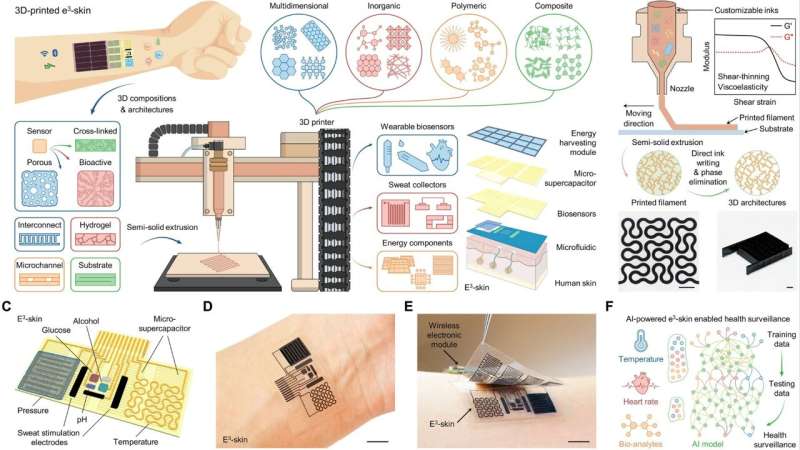In a recent study published in Science Advances, researchers from the California Institute of Technology, led by Dr. Wei Gao, have developed a machine learning (ML)–powered 3D-printed epifluidic electronic skin for multimodal health surveillance. This wearable platform enables real-time physical and chemical monitoring of health status.
Wearable health devices have the potential to revolutionize the medical world, offering real-time tracking, personalized treatments, and early diagnosis of diseases.
However, one of the main challenges with these devices is that they don’t track data at the molecular level, and their fabrication is challenging. Dr. Gao explained why this served as a motivation for their team.
“Nowadays, there is increasing research interest in personalized health care to revolutionize traditional medical practices. To overcome these challenges, we employ our 3D printing technology to create essential components, such as physical sensors, chemical sensors, microfluidics, and supercapacitors, for our wearable platform,” Dr. Gao told Phys.org.
Dr. Gao and his team have done exactly that by realizing the mass-production of a wearable platform called e3-skin, which is 3D printed on customized materials.
e3-skin: A 3D-printed epifluidic electronic skin
The name e3-skin is derived from “epifluidic elastic electronic skin.” It is a 3D-printed wearable system that continuously monitors various physiological parameters and predicts behavioral responses.
Dr. Gao explained the various components of e3-skin, saying, “All main components of the wearable platform, including physical sensors, chemical sensors, microfluidics, and energy storage micro-supercapacitors, could be readily prepared via extrusion 3D printing of various functional materials.”
What sets the e3-skin apart are the 3D-printed biochemical sensors and microfluidics system. The integration of 3D printing technology is a pivotal aspect of the e3-skin’s creation.
3D printing offers precision and customization, allowing researchers to precisely design and manufacture essential components. This streamlined production and enabled the integration of complex structures and materials, including the 3D-printed biochemical sensors and microfluidics.
Dr. Gao further elaborated, “Wearable biochemical sensors could provide crucial health information at molecular levels. When coupled with biophysical sensors, they can provide more comprehensive information about our health state.”
Moreover, the use of microfluidics, the science of manipulating and controlling tiny amounts of fluids within small channels or devices, has helped them to analyze the biomarkers in human sweat. Microfluidics can induce sweat automatically through iontophoresis, collect it without the need for strenuous activity, minimize sweat evaporation, and facilitate real-time biochemical analysis with fresh sweat samples.
ML-assisted wearable medical technology
The e3-skin’s capabilities extend beyond its hardware components. It integrates ML algorithms, which play a pivotal role in its functionality. But before delving into ML, it’s essential to understand the remarkable material that makes the e3-skin possible: MXene.
MXene, a family of 2D materials, is a versatile material known for its unique properties. Aqueous Ti3C2Tx (MXene) served as the ink to 3D print the interconnects and biophysical sensors in the e3-skin.
The team used the MXene to address a limitation with current wearable systems. In the words of Dr. Gao, “Most current wearable systems rely on batteries, which are rigid, bulky, and insufficient, necessitating frequent replacement.”
To address this limitation, the e3-skin integrates a solar cell, harvesting energy from ambient light and efficiently storing it in 3D-printed MXene-based micro-supercapacitors. This innovation enables battery-free, sustainable operation for long-term health monitoring during daily activities.
MXene nanosheets possess properties such as negatively charged surfaces and hydrophilicity, which enable them to disperse and remain stable in water. This allows for precise printing, with MXene filaments having adjustable line widths and the ability to adhere to flexible substrates, like human skin.
Dr. Gao further emphasized, “The printed MXene filaments can form uniform arrays with intricate patterns, enabling the creation of complex structures within the e3-skin.”
MXene’s versatility extends to temperature sensing, with sensors exhibiting a negative temperature coefficient and wear stability.
For pulse monitoring, MXene, in combination with carbon nanotubes, forms sensors with customizable foam designs, ensuring high sensitivity and durability. Notably, this enables reliable radial pulse monitoring on human subjects.
Furthermore, the e3-skin’s capabilities extend to predicting behavioral responses to alcohol consumption, which they demonstrated. Dr. Gao stated, “In our case, we used the e3-skin to collect both sweat alcohol and vital signs (such as heart rate and skin temperature) information, providing more comprehensive insight into behavioral responses.”
ML analyzes this data to predict an individual’s response time and degree of impairment. Sweat alcohol plays a pivotal role in predicting response time, while heart rate complements sweat alcohol for more accurate impairment prediction.
The future of wearables
e3-skin shows great promise, harvesting the best of ML, materials, and medicine. “e3-skin provides exciting opportunities to advance wearable biosensors toward practical applications in modern health care,” highlighted Dr. Gao.
With its continuous monitoring of vital biomarkers and extensive data collection, it has the potential to predict cognitive and behavioral impairments and monitor various health aspects.
The data collected by the e3-skin could enhance personalized health care by allowing early warning, early diagnosis, and timely intervention to maximize health outcomes.
Dr. Gao concluded by stating, “The large sets of data collected by such multimodal wearable devices in daily activities coupled with modern ML algorithms can extract the underlying relationship of the biomarker level with complex health conditions.
“Thereby, it promises to reshape the field of wearable health monitoring and empower data-driven personalized health care.”


